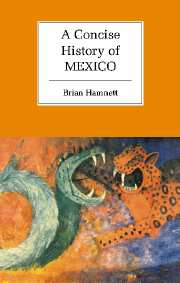Book contents
- Frontmatter
- Contents
- List of illustrations
- Preface
- 1 Mexico in perspective
- 2 The pre-Columbian era
- 3 The European incursion, 1519–1620
- 4 New Spain, 1620–1770: Spanish colonialism and American society
- 5 Destabilisation and fragmentation, 1770–1867
- 6 Reconstruction, 1867–1940
- 7 The monopoly party, 1940–2000
- Final comments
- Bibliography
- Index
5 - Destabilisation and fragmentation, 1770–1867
Published online by Cambridge University Press: 05 June 2012
- Frontmatter
- Contents
- List of illustrations
- Preface
- 1 Mexico in perspective
- 2 The pre-Columbian era
- 3 The European incursion, 1519–1620
- 4 New Spain, 1620–1770: Spanish colonialism and American society
- 5 Destabilisation and fragmentation, 1770–1867
- 6 Reconstruction, 1867–1940
- 7 The monopoly party, 1940–2000
- Final comments
- Bibliography
- Index
Summary
During this period a relatively prosperous society organised as the Spanish colonial Viceroyalty of New Spain became transformed into a weak and divided Mexican Republic. How this process took place and what it implied continues to provoke disagreement in the historical literature. Until 1821, New Spain formed part of a wider Spanish imperial entity. The metropolis gave priority to the interests of the Empire as a whole rather than to any specific part of it. Spanish government support for the Mexican mining industry, while it benefited Mexican investors in the short term, was designed to promote not Mexican but imperial interests. The high stakes involved in the mining industry helped to explain both government and investor neglect of the cereal sector, vulnerable at a time of population recovery.
Spain itself also formed part of the imperial system, though by the 1780s and 1790s it became clear that the metropolis did not have sufficient resources to sustain the imperial burden for much longer, in the face of increasing international competition. The disintegration of the Spanish financial system under the pressure of warfare in the 1790s and 1800s increased metropolitan pressure on the Mexican Treasury General. After 1796, Spain effectively depended more and more on Mexican subsidies to sustain its faltering position.
- Type
- Chapter
- Information
- A Concise History of Mexico , pp. 112 - 176Publisher: Cambridge University PressPrint publication year: 1999

